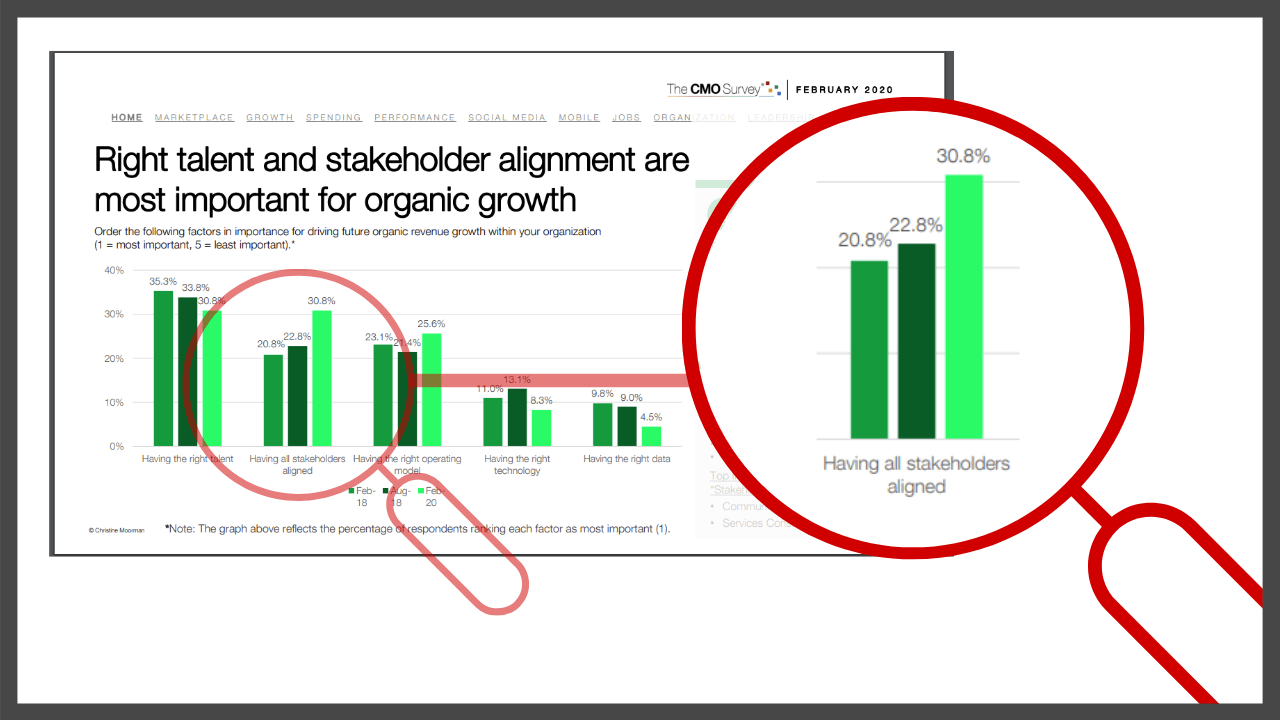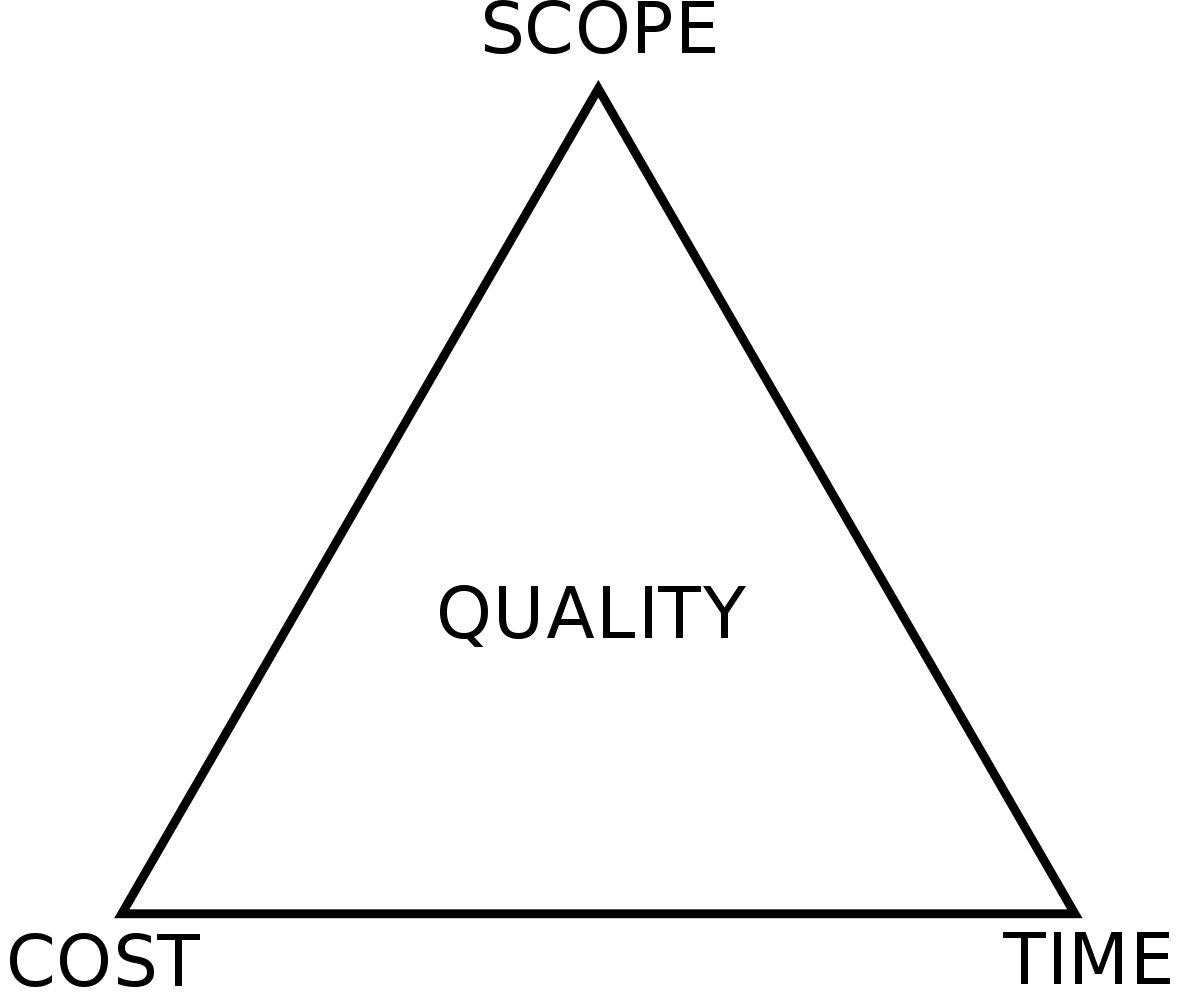How to Gain Stakeholder Alignment
How to gain stakeholder alignment is on the minds of many marketers these days. In the February 2020 CMO Survey – conducted in partnership by Deloitte, Duke and AMA – marketing leaders indicated that “Having all stakeholders aligned” was a key to driving revenue growth. As a matter of fact this indicator saw the biggest jump from the previous 6-month report and seems to be on a significant upward trend.
In our experience there are three major parts to stakeholder alignment when it comes to successful marketing execution:
-
Alignment on Goals
-
Alignment on Roles
-
Alignment on Mindset
Let’s tackle how to gain stakeholder alignment by looking at these three parts, one at a time.
ALIGNMENT ON GOALS
Many times stakeholders believe that if you can achieve alignment on goals, then you’re done. We don’t see it that way. Don’t take us wrong, alignment on goals is crucial and most companies do this quite well.
Getting stakeholders aligned on goals requires conversations to start at the strategic level and work their way down into manageable strategies and tactics that can be executed on by the marketing department.
Stakeholders should be asking how marketing can support:
-
the overarching strategic direction of the company? Questions to consider are:
-
- Impact of market forces?
- Pursuit of new markets?
- Product innovations?
- Shift in business model or pricing?
- Mergers or acquisitions?
-
-
the stated company goals for this year? Questions to consider are:
-
- Where is revenue growth projected to come from?
- What’s the timing of any special project, initiatives or releases?
- Is the tech-stack changing (ie: new website? CRM? etc.)?
-
-
The quarterly goals that have been set? Questions to consider are:
-
-
- What can we learn from historic performance?
- Is seasonality a consideration?
- When have budget adjustments occurred, should we be anticipating them in our current context?
- If we had to rank goals in order of importance, what are the top 3 for this quarter?
-
-
The monthly goals and KPIs that roll up to these quarterly and annual goals?
-
-
- Monthly goals and KPIs is where the rubber hits the road. Here you’re making decisions on strategies, tactics, budget allocation based on all of the previous conversations. All of these goals must roll up under the quarterly goals – which in turn should be aligned with the annual goals and the company’s strategic direction.
- Monthly goals need to be S.M.A.R.T.
-
A S.M.A.R.T. goal is:
Specific
Measurable
Achievable
Relevant
Time-based
Like we said in the beginning, most companies do a good job at this. At Augurian we’ve created a Digital Operating System that ensures alignment of goals. We do this by having agreed upon – clearly stated goals, assigned accountability and tracking and reporting that is transparent and available to all stakeholders at all times.
However, in our experience, Alignment on Goals is only one leg of the stakeholder alignment stool. The other two feet of the stakeholder alignment stool are extremely important for CMO’s and marketing departments: Alignment on Roles and on Mindset. Most marketers and marketing departments really begin to have problems when misalignment occurs in either of these two areas.
ALIGNMENT ON ROLES
When it comes to getting more customers and achieving growth goals – everyone has their point of view and because we’re talking about marketing, everyone’s opinion seems to carry the same weight. There are opinions on the messaging, the visual design, the user interface, the website and the list goes on and on. Sales teams will talk about how bad their leads are, finance will ask what the ROI is, leadership will make decisions on vendors or tech stack without sufficient input from the marketing team.
Now, we’re not suggesting that the tail wags the dog and marketing calls all the shots. Or that sales doesn’t have the right to question lead quality or finance to ask about ROI. However, the most effective marketers we’ve worked with own their craft and set themselves up for success by creating clear roles and establishing agreed upon sources of truth. Basically, they get ahead of the game and have their fingertips on so much data that they can answer all of the questions – ensuring people stay in their lane.
So, in order to be respected and perceived as an expert in your craft by other stakeholders – what we’re calling “alignment on roles” – you’ve got to do a few things on a consistent basis:
-
You must operate with precision
- Once goals are set and KPIs are established, stick to them. Remind other stakeholders what you’ve all agreed to. Don’t just accept a new initiative that falls on your plate or get bullied into changing goals or KPIs. If changes need to be made mid-stream, then make them with complete agreement and acknowledgement that this new direction is a departure from what was previously agreed upon.
-
You always have to provide data and insights to back you up.
- Effective marketers rely on data to shape a narrative about their work and uncover the insights that other stakeholders can use to take action.
-
Always be honing your craft.
- Follow thought leaders, read blogs and industry journals, attend conferences and participate in webinars. You should try to be the most up-to-date, forward thinking stakeholder when it comes to marketing.
ALIGNMENT ON MINDSET
This is probably the most important aspect of stakeholder alignment and the most difficult to achieve. Marketers who are able to succeed in their roles for years are masters at two critical aspects of organizational mindset alignment:
-
Developing a “Testing Mindset”
Savvy marketers are able to influence other stakeholders to view marketing as science. You start with a hypothesis, you set up an experiment and test this hypothesis and once the experiment is finalized you look at the data and derive insights from it. These insights inform your next hypothesis and you repeat the process over-and-over again.
Organizations that have adopted a testing mindset are willing to try new ideas, with the full knowledge that some of the experiments will ultimately fail (or get worse results than the status quo). The best part about this scientific approach is that learning is derived from both successful and failed experiments.
The testing mindset also allows for marketers to take suggestions from other stakeholders and say “we should test that!”. This philosophy gives marketers the ability to accept recommendations, letting other stakeholders be “heard” while not turning over complete control for messaging or design, basically letting the results of the experiments speak for themselves.
-
Developing a “Something Has To Give Mindset”
Probably the most important role of a marketer is to effectively manage projects and expectations. One of the most effective tools that has been used for decades is the project management triangle.
Gaining buy-in from stakeholders and the entire organization on the merits of the project management triangle is crucial. First the organization must agree that quality work is constrained by the amount of budget put toward the project, how quickly the project needs to be completed, and how big of a scope the project has.
If all stakeholders agree that these are the key constraints, then they’ll recognize the trade offs between these constraints. Changes in one constraint will necessitate changes in others to compensate or the quality of the project will suffer.
For example, a project can be completed faster by increasing budget or cutting scope. Similarly, increasing scope may require equivalent increases in budget and schedule. Cutting budget without adjusting schedule or scope will lead to lower quality.
With the project management triangle – something always has to give. Marketers who can clearly articulate the impacts decisions make on projects, using the project management triangle, will have a high degree of stakeholder alignment.
Conclusion
If you want to understand how to gain stakeholder alignment, then focus on these three key elements:
-
Alignment on Goals
-
Alignment on Roles
-
Alignment on Mindset
Knowing exactly what goals and KPIs you’re pursuing and how they role up to the larger organizational goals is important, ensuring that you’re seen as the expert in the marketing domain always backed by data and developing a “testing” and “something’s got to give” mindset will help you achieve what many marketing leaders indicated as a key to driving revenue growth – stakeholder alignment.
If you’re interested in learning more about Augurian’s Digital Operating System and how it helps our teams stay aligned with our clients and their internal stakeholders, please contact us.





